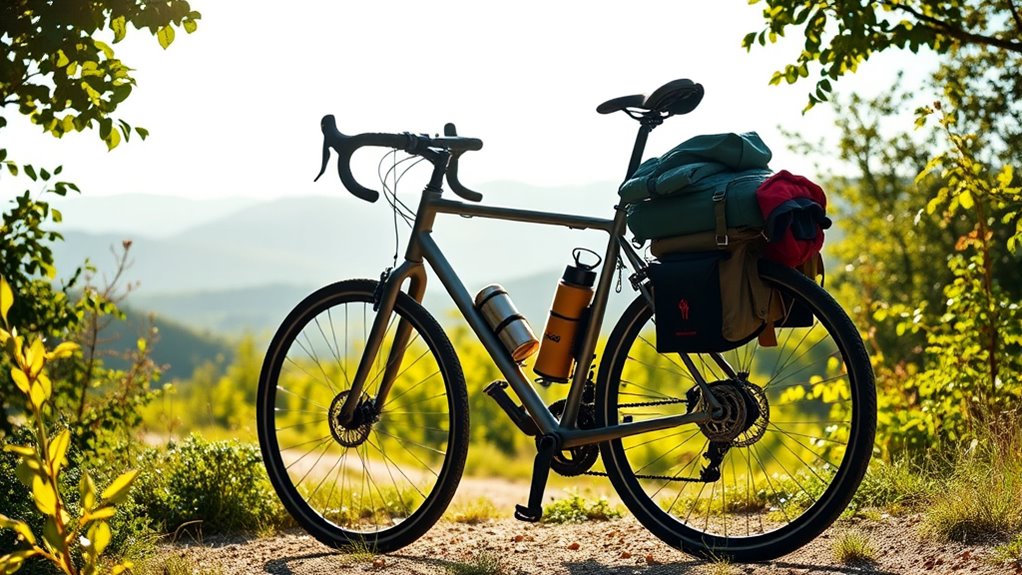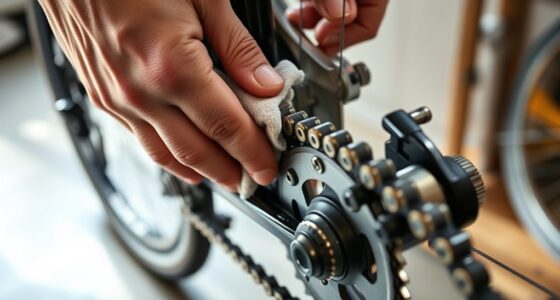To pack light for your multi-day cycling trip, focus on essential gear like a helmet, hydration bottles, and maintenance tools. Layer your clothing for versatility, choosing quick-dry fabrics and a waterproof outer shell. Use strategic packing techniques like waterproof bags and packing cubes to optimize space. Don’t forget toiletries and some cash for emergencies. Organizing your luggage well will enhance your cycling experience. For more tips on specific items to bring, keep exploring!
Key Takeaways
- Prioritize lightweight, multifunctional clothing made from quick-dry fabrics to minimize bulk and ensure comfort during cycling.
- Use waterproof bags and packing cubes for organized, space-efficient packing and to keep gear dry.
- Limit clothing to essentials and roll items in towels for efficient drying and easy storage.
- Opt for versatile panniers that can convert to backpacks for flexibility while on the go.
- Keep repair tools and first-aid kits easily accessible for quick maintenance and safety during the trip.
Assessing Your Destination and Climate
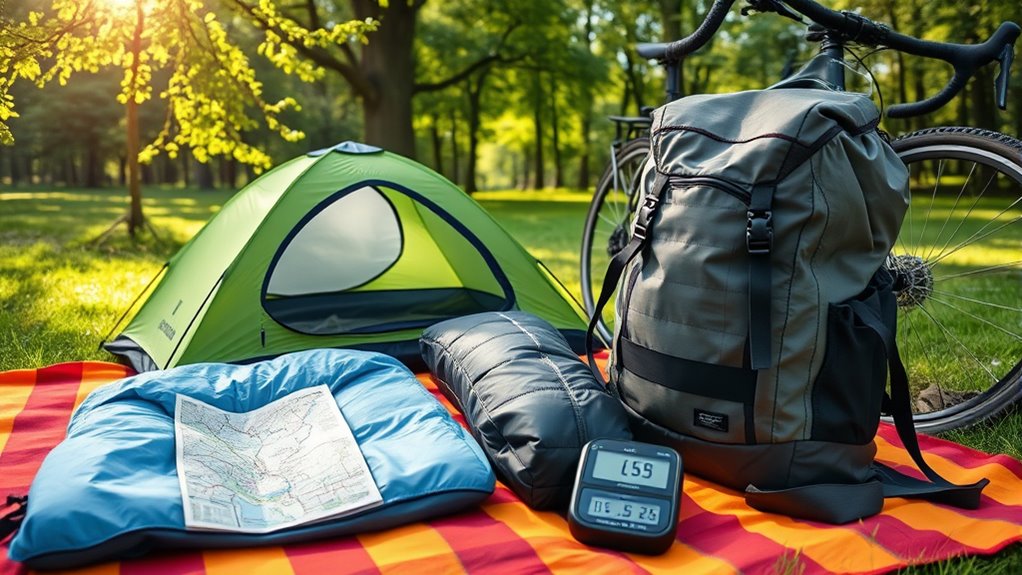
When planning your cycling trip, it’s essential to assess your destination and its climate, as these factors can significantly influence your experience.
Look for routes with stunning landscapes, including water bodies and green spaces, which enhance your ride. Consider the built environment; historical landmarks and cultural events can make your journey more enjoyable.
Evaluate the road network—check traffic flow, road width, and existing cycling infrastructure to ensure a safe and comfortable ride.
Understand average temperatures and typical weather conditions during your travel period, as this helps you pack appropriately.
Lastly, stay informed about wind patterns and daylight hours, as they’ll impact your cycling speed and daily plans.
Being aware of these elements will make your trip more pleasant and well-prepared.
Essential Cycling Gear to Bring
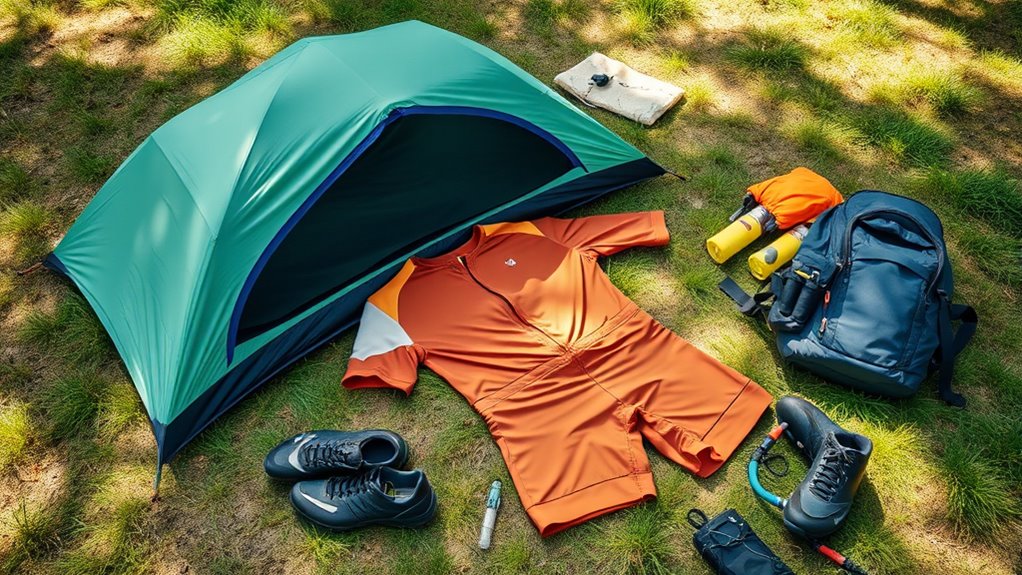
Packing the right gear is crucial for a successful cycling trip, as it ensures you stay safe, comfortable, and prepared for any situation.
Packing the right gear is vital for a successful cycling trip, ensuring safety, comfort, and readiness for any situation.
Start with your helmet, which is often not included with bike rentals. Don’t forget bike shoes for efficient pedaling and comfort, plus sunglasses to shield your eyes from glare and debris.
Bring front and rear lights to enhance visibility, especially in low light. Hydration is key, so pack two large water bottles.
For maintenance, a multi-tool, pump or gas canisters, inner tubes, and tire levers are essential.
Lastly, include a first aid kit, reflective gear, and a bike lock to secure your ride when you stop. These essentials will keep you ready for anything on your journey.
Layering Your Clothing for Versatility

Layering your clothing effectively can make all the difference on a cycling trip, as it allows you to adapt to changing weather conditions with ease.
Start with a moisture-wicking base layer made of merino wool or synthetic fabric to keep you dry. Add a mid-layer, like a lightweight fleece, for insulation when temperatures drop.
For outer protection, choose a waterproof and windproof shell, such as Gore-Tex, to guard against the elements. Don’t forget leg layers like tights or warmers for colder rides.
Accessories like arm warmers and gloves can provide extra warmth as needed. By packing versatile layers, you can easily adjust your outfit to stay comfortable, no matter the weather.
Strategic Packing Techniques

Maximizing efficiency in your gear organization can significantly enhance your cycling experience. Choose waterproof bags to keep your gear dry, and opt for multi-compartment bags to streamline access.
Packing cubes can help you categorize items, while compression bags reduce bulky volumes, freeing up space. For versatile options, select panniers that can convert into backpacks or shoulder bags.
Categorize your gear—assign specific bags for different items to facilitate quick access. Distribute weight evenly on your bike for better balance, and store frequently used items in top tube bags.
Ensure your valuables are secure in jersey pockets or removable pouches. Lastly, keep repair tools and first-aid kits easily accessible for peace of mind on your journey. Additionally, consider using Leave No Trace principles to minimize your impact on the environment during your travels.
Toiletries and Hygiene Essentials

How can you ensure you stay fresh and clean during your cycling trip? Start by packing a bar of soap instead of shower gel; it’s lighter and versatile.
For your hair, grab travel-sized shampoo bottles to save space. Toothpaste tablets or small tubes work well for dental hygiene. A roll-on deodorant prevents spills, while a compact hairbrush keeps your locks tidy.
Don’t forget hand sanitizer for quick clean-ups when water isn’t available. Plan to do laundry every few days using biodegradable soap, and lay clothes flat on a towel to dry faster.
Lastly, pack essentials like a lightweight toothbrush, razor, nail clippers, and biodegradable wet wipes to maintain hygiene and comfort throughout your journey.
Electronics and Charging Solutions
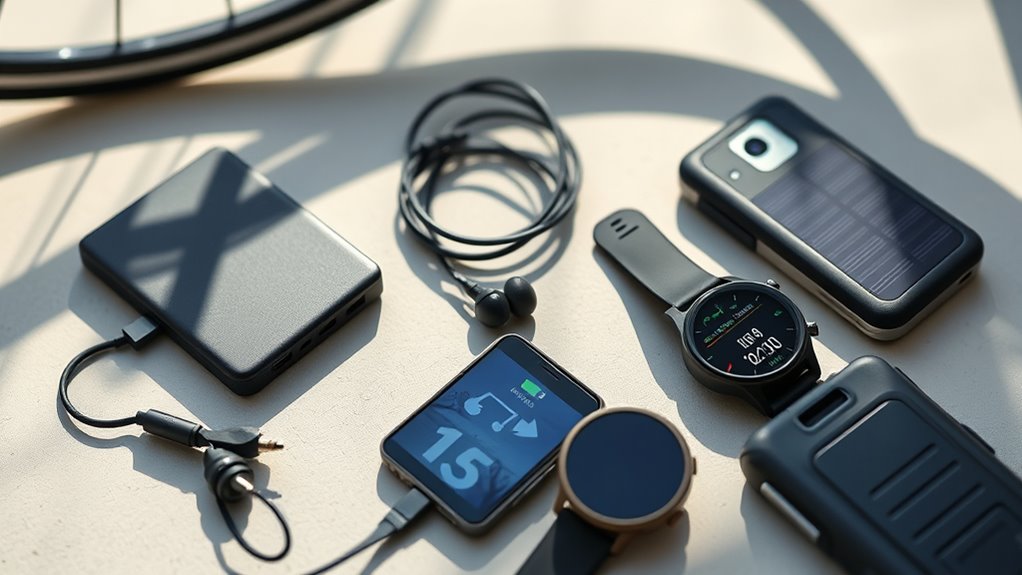
While setting off on your cycling trip, packing the right electronics can make all the difference in staying connected and navigating your route. Be sure to include your mobile phone and charger for emergencies and navigation. A universal travel adapter is essential if you’re traveling abroad.
Consider a GPS device or smartphone navigation app, but don’t forget backup maps. For capturing memories, pack a camera and its charger.
Charging solutions like external battery packs and solar panels are invaluable for on-the-go power. Waterproof phone cases and device bags protect your gear from the elements.
Lastly, pack earphones for downtime and a multi-USB charger to keep everything powered up. This way, you’ll stay connected and ready for any adventure. Additionally, consistent maintenance of your devices will ensure they perform optimally throughout your trip.
Managing Money and Payment Options
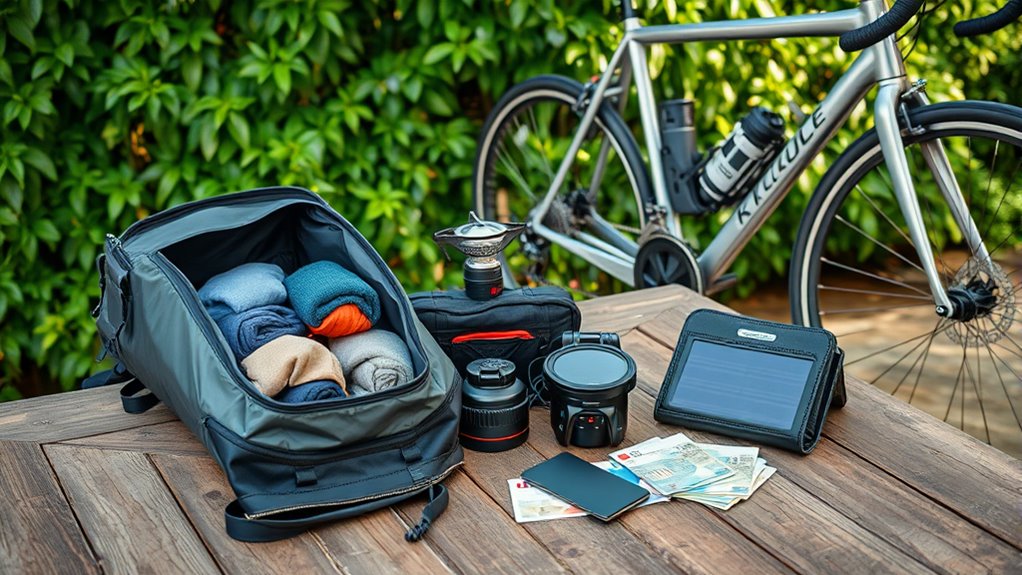
Managing your finances on a cycling trip is crucial for a smooth experience. Carry multiple bank cards from different banks to avoid account blockages during foreign transactions. Use cards linked to international networks like Visa or Mastercard for easy cash access.
Be aware of withdrawal fees, and consider banks that offer fee-free international withdrawals. Always have a small amount of cash and traveler’s checks as a safety net. Set a daily budget and track your expenses to stay within limits.
Notify your banks of your travel plans to prevent issues. Lastly, research local payment options and currency exchange rates to manage your funds effectively and avoid scams. With over 70% of Americans applying for credit cards online, it’s wise to ensure your payment methods are secure and reliable.
With these strategies, you’ll navigate your finances with confidence.
Organizing Your Luggage Efficiently
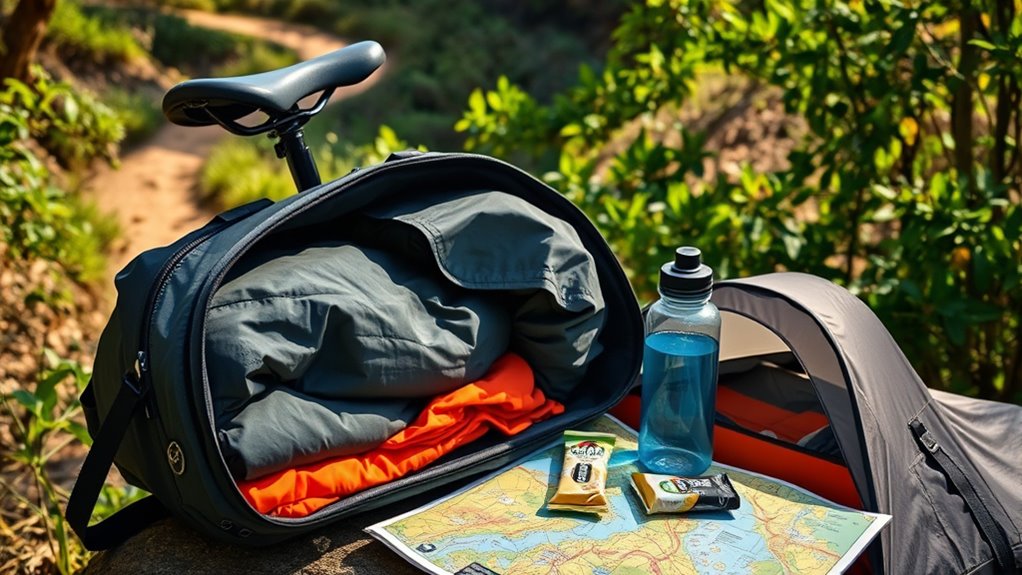
To make your cycling trip more enjoyable, organizing your luggage efficiently is essential.
Start by choosing the right equipment, like lightweight panniers or bikepacking bags, to keep your load balanced. Distribute weight evenly on your bike, placing heavy items near the center and lighter ones in saddlebags.
Choose lightweight panniers or bikepacking bags for a balanced load, placing heavier items near the center for optimal stability.
Categorize your gear by assigning specific bags for different types of equipment, ensuring frequently used items are easily accessible in handlebar or top tube bags. Use compression sacks to save space for clothing, and keep valuables in secure pockets.
Finally, test your setup before hitting the road to ensure comfort and functionality, making adjustments as needed for a smoother ride.
Happy cycling!
Preparing for Laundry Needs on the Trip
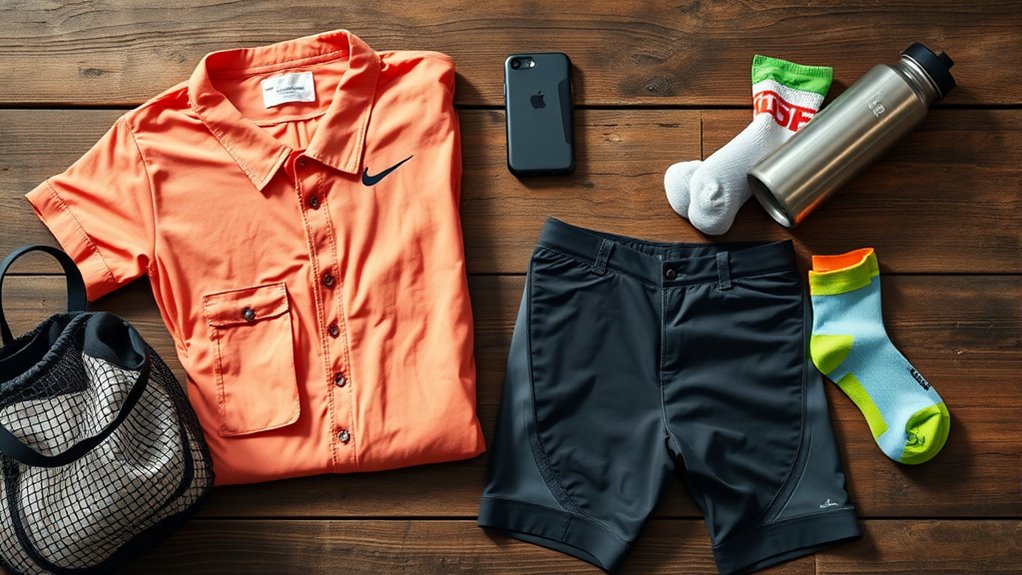
As you embark on your cycling trip, preparing for laundry needs can make a big difference in your overall comfort and hygiene.
Start by packing lightweight, quick-drying clothing, which minimizes laundry needs. Bring mild or biodegradable detergent to protect your gear. Identify accessible water sources, like public fountains or hotel sinks, for washing.
Regularly wash key items like underwear and cycling shorts. Use the shower technique for quick washes or a sink for more delicate fabrics. In remote areas, consider the plastic bag method for on-the-go cleaning.
To dry clothes, roll them in towels to remove excess moisture and hang them in sunlight, ensuring they’re stored in a dry, ventilated space.
Frequently Asked Questions
How Do I Choose the Right Bike for My Trip?
When you’re choosing the right bike for your trip, focus on versatility and comfort.
Look for a bike with a sturdy frame that handles rough terrain well and features like disc brakes for better stopping power. Wider tires improve stability, while low gearing helps on hills.
Make sure it has mounts for luggage and simple components for easy maintenance.
Lastly, don’t forget to test ride it before heading out to ensure it feels right.
What Snacks Should I Pack for Energy During Cycling?
Did you know that cyclists can burn up to 600 calories per hour? To keep your energy levels up, pack a mix of snacks.
Opt for energy bars like Clif Bars for quick carbs or natural options like bananas and sweet potatoes for sustained energy.
Don’t forget energy chews or gels for a fast boost. Variety’s key, so include different snacks to keep your taste buds happy during your ride!
How Can I Stay Motivated on Long Rides?
To stay motivated on long rides, focus on positive self-talk to boost your endurance.
Set SMART goals to keep your mind engaged, and break the distance into smaller segments to make it manageable.
Embrace humor to lighten your mood and refresh your perspective.
Riding with friends can enhance your motivation, while reflecting on past achievements reminds you of your capabilities.
Remember to monitor your progress and stay aware of your physical needs during the ride.
What Safety Precautions Should I Take While Cycling?
When cycling, you should prioritize safety by always wearing a helmet and ensuring your bike’s in good condition.
Use reflective gear and bright clothing to boost visibility, especially in low light.
Stay alert for hazards, signal your intentions with hand signals, and follow traffic rules.
Carry a first aid kit and a small tool kit for emergencies, and plan your route to avoid heavy traffic.
How Do I Deal With Bike Maintenance on the Road?
When you’re on the road, it’s crucial to stay on top of bike maintenance. Start with daily inspections, checking tire pressure and chain condition.
Lubricate the chain as needed, especially after wet rides. Always carry a multitool for quick adjustments and spare tubes for flat tires.
Familiarize yourself with basic repairs, and don’t forget to identify local bike shops along your route for those unexpected issues.
Safety gear is a must, too!
Conclusion
By packing light for your multi-day cycling trip, you not only make your ride easier but also enhance your overall experience. There’s a theory that less gear leads to more freedom and adventure. Think about it: when you’re not weighed down, you can explore more, embrace spontaneity, and truly enjoy the journey. So, ditch the excess and embrace simplicity. You might just discover that the best memories come from unplanned detours and lighter loads. Happy cycling!
